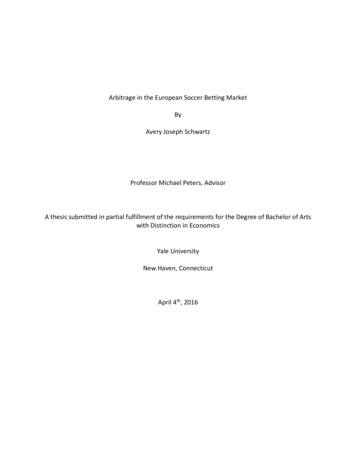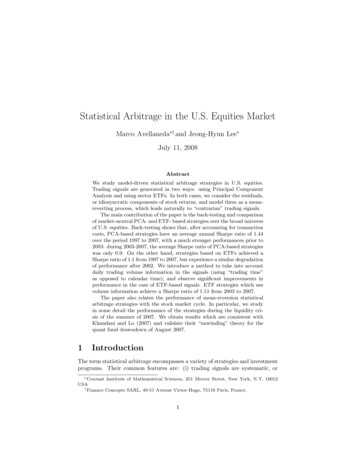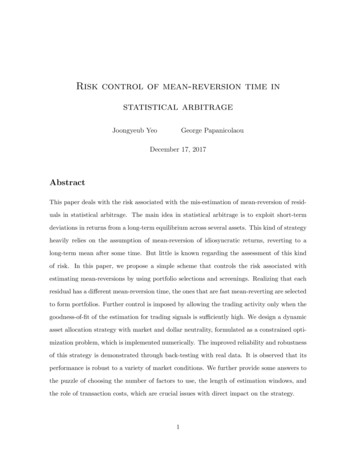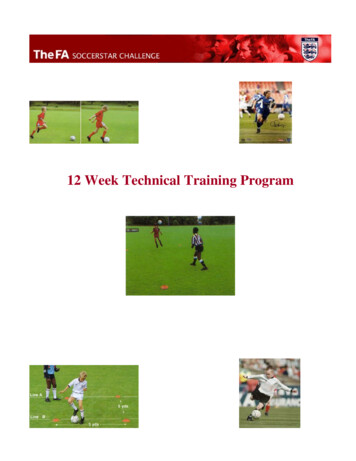
Transcription
Arbitrage in the European Soccer Betting MarketByAvery Joseph SchwartzProfessor Michael Peters, AdvisorA thesis submitted in partial fulfillment of the requirements for the Degree of Bachelor of Artswith Distinction in EconomicsYale UniversityNew Haven, ConnecticutApril 4th, 2016
Avery SchwartzAbstractThis paper will explore the European soccer betting market and its fundamental ties tounderlying economic theory. By studying the odds of English Premier League soccer gamesposted on seven different betting websites, I was able to discover significant arbitrageopportunities that have only become available in recent years. Additionally, I provide a theoryas to why this arbitrage exists and why it is a relatively recent phenomenon. I suggest thatcompetition between different betting websites has caused the initial odds offered by the sitesto get close enough to fair game values that random drift can cause the odds on different sitesto vary by an amount great enough to allow for arbitrage. I also conclude that the arbitrageavailable in the sports betting market should be considered limited arbitrage based onShleifer’s definition, which states that arbitrage opportunities with perfect substitutes can stillbe limited in the real world if an arbitrageur must worry about maintaining the position. 1Part 1 - IntroductionThe size of the online gambling market is projected to surpass forty-five billion dollars in2016, which would represent an eighty-five percent increase since 2009. 2 Additionally, it isestimated that sixty-five percent of global sports betting occurs on soccer matches. 3 Despitethe massive size and growth of this market, there has been very little academic research intothe nature of online betting markets. In this paper, I examine the online European soccerbetting market by studying all games played in the English Premier League, the world’s mostcommercially successful soccer league, from the 2000/01 to the 2014/15 season. I tested theefficiency of the online betting market for the English Premier League by examining the odds on2
Avery Schwartzseven different betting websites (Bet365, Bet&Win, Interwetten, Ladbrokes, Stan James,William Hill, and VC Bet) and studying whether arbitrage opportunities existed. I found that itwas possible to find significant arbitrage opportunities by combining the best odds fromdifferent sites on an individual game. The exact definition and nature of this arbitrage will bediscussed later in the paper. To start, a game was considered to offer an arbitrage opportunityif a series of bets could be placed that would lead to a profit in every possible outcome.The textbook definition of arbitrage is, “the simultaneous purchase and sale of thesame, or essentially similar, securities in two different markets at advantageously differentprices.” 4 Typically, this is applied to financial markets, where, in the most basic example, anarbitrageur could buy some security in Market A for some price P1 and simultaneously sell thatsecurity in Market B for some price P2, where P1 P2. Without taking on any risk, the arbitrageurwould collect the price difference. With betting on soccer matches through online betting sites,arbitrage becomes more complicated because it is impossible to “sell” the security, and thereare three possible outcomes: a home win, a draw, and an away win. Therefore, to capturearbitrage three simultaneous bets must be placed (one on each result) that would each pay outmore than the total amount wagered.In Europe, odds are typically given in decimal form, where the amount paid out in theevent of a win is the amount wagered multiplied by the decimal odds. For example, if the oddsof the home team winning are 2.5 and an individual wagers ten dollars on that outcome, theindividual would receive twenty-five dollars if the home team were to win. In this study, to testwhether or not the odds on the various sites offered an arbitrage opportunity for a given game,I first identified the best odds for each outcome and then calculated if arbitrage was available3
Avery Schwartzusing a simple equation. To calculate whether arbitrage is possible given a set of three odds, wecan use equation (1) 5:1/H 1/D 1/A XIn this formula, H represents the stated odds that the home team will win, D representsthe stated odds that the game will end in a draw, and A represents the stated odds that theaway team will win. The reason that this equation is able to detect arbitrage given a certain setof odds is that one divided by the stated odds is equivalent to the implied probability of a givenevent. For example, if the stated odds of an outcome are 2, then the implied probability of thatoccurring is 1/2, or fifty percent. Therefore, if “fair odds” are given, X should be one, because asthere are three possible outcomes, the total probability of one of the three outcomes occurringis one. The concept of fair odds will be developed later in the paper as analogous to a “fairgame,” where the expected profit is 0. If X is greater than one, the stated odds imply that theprobability of one of three states occurring is greater than one, which is not possible. As thecost of a bet can be thought of as the probability of the event occurring, if X is greater than onethen the combined basked of odds is overly expensive, and there are no arbitrageopportunities. Using the same logic, if X is less than one there is an arbitrage opportunity. Therisk-free profit that can be generated from the opportunity can be calculated using equation(2) 6:P (S/X) – SThis equation simply states that profit (P) is equal to the total amount invested (S)divided by X minus the amount invested (S). The key to arbitrage betting is that the properamount of money must be wagered on each outcome, so the result is the same profit in all4
Avery Schwartzpossible scenarios. Therefore, the arbitrageur should be ambivalent to which state actuallyends up occurring. The amount to bet on each game can be found by using equation (3)7:B(H,D,A) (S*(1/(H,D,A))/XIn this equation, B stands for the bet size on a specific state (home win, draw, or awaywin) and S stands for the combined stake invested in all three bets. So, the equation states thatthe proper bet size on a given state is equal to the total investment multiplied by the impliedprobability of that state divided by the implied probability of all states. It is useful to look at anexample in order to better quantify these ideas. In this example I will use two fictitiousbookmakers, which both provide odds on all three possible outcomes of one game. The oddsfor each outcome vary slightly across bookmakers. I shall assume a total investment of 1000.BookmakerHome Team WinDrawAway Team WinY243.5Z1.535In this simple state, neither bookmaker is offering arbitrage by betting on all threeresults on one site, but by combining the best odds for each possible outcome it is possible tounlock arbitrage. To do this, an arbitrageur would bet on the home team to win on bookmakerY, a draw on bookmaker Y, and the away team to win on bookmaker Z. Using equation (1), thiswould give us an implied probability of:X (1/2) (1/4) (1/5) 0.95As X is less than one, we know that we have an opportunity for riskless profit. Using equation(2), we can discover how much risk-free profit is in this opportunity given a 1000 investment.5
Avery SchwartzP 1000/0.95 - 1000 52.63Therefore, we know that by taking advantage of this arbitrage opportunity we will earn 52.63(5.3%) in riskless profit. To decide how much to bet on each state we use equation (3):B(H) ( 1000/2)/.95 526.32B(D) ( 1000/4)/.95 263.16B(A) ( 1000/5)/.95 210.52The total investment is merely B(H) B(D) B(A), which is 1000. Independent of the actualresult, we know we will receive 1,052.36, for 52.36 of risk-free profit.Using the equations above, I tested for arbitrage in every game of the English PremierLeague from the 2000/01 season to the 2014/15 season. Unlike any study known to the author,I was able to find significant patterns of arbitrage in English Premier League games by usingodds from different sites. The first game to offer an arbitrage opportunity occurred in the2007/08 season, and the number of games offering arbitrage has steadily increased each yearsince. In addition to the number of arbitrage opportunities increasing over time, the averageexpected return for each betting site declined in every year in the study. The average expectedreturn for a betting site was calculated based on equation (1), with the return to the betting sitebeing equal to X minus one. This is a legitimate approximation for the return for betting sitesassuming that the sites have a balanced book, where the bookmaker makes the same profitindependent of the outcome. This pattern leads me to postulate that increasing competitionbetween betting sites has caused the average odds bookmakers initially give to continuallymove closer to “fair value” odds. Fair value odds occur when the implied probability of alloutcomes (X) is equal to one. As each bookmaker then rationally adjusts their own odds to6
Avery Schwartzattempt to balance their book, discrepancies between bookmakers can become large enough toallow for an arbitrage opportunity.In order to properly establish the connections between arbitrage in soccer bettingmarkets and fundamental economic theory, the remainder of the paper will be structured asfollows: Part 2 will establish the theoretical history and framework of the Efficient MarketHypothesis and will explore the connections between the Efficient Market Hypothesis andarbitrage. Part 3 will introduce the theoretical history and framework of refutations of theEfficient Market Hypothesis, further discuss the role of arbitrage in the debate of efficientmarkets, provide various definitions for arbitrage, and discuss examples of arbitrage that haveoccurred in the real world. Part 4 will briefly discuss the few pieces of literature that havepreviously examined arbitrage in sports betting markets. Part 5 will introduce the data andresults found in this paper and will introduce my theory that competition and noise, which arerepresented by shrinking profits and random drift, has led to the increase in arbitrageopportunities seen in the data. Part 6 will introduce a simple model where I will attempt toshow that the results found in this paper can be explained by my theory of competition andnoise, and that arbitrage can occur even as bookmakers and the individuals betting all actrationally. Part 7 will discuss the nature of the arbitrage offered in the soccer betting market.Part 8 will conclude.Part 2 – A Brief Synopsis of the Efficient Market HypothesisThe definition of an efficient market according to Eugene Fama’s famous 1970 paper,“Efficient Capital Markets: A Review of Theory and Empirical Work,” is that an efficient market7
Avery Schwartzalways fully reflects all available information, which suggests that it is impossible for an investorto generate above average returns. 8 This idea of efficient markets is inherently tied toarbitrage. In fact, according to Andrei Shleifer, the efficiency of markets is actually dependentupon arbitrage being able to function in the real world as it does in efficient market modelssuch as those put forward by Fama and Friedman. 9 However, the importance of the connectionbetween arbitrage and efficiency is not necessarily intuitive. It stems from the idea that thebasic theoretical case for the Efficient Market Hypothesis relies on three core assumptions. 10The first is that investors are assumed to be rational, which means that they value securitiesrationally. 11 If all investors are rational, then markets are efficient by definition. The second isthat even if some investors are not rational, as long as irrational investors deviate fromrationality in random ways the irrational investors will cancel each other out and markets willremain efficient. 12 The third is that even if irrational investors deviate from rationality in nonrandom ways, arbitrage can act as a force to ensure markets remain efficient.13 Therefore, ifthese assumptions hold then markets must be efficient. In fact, much of the theoretical attackon the Efficient Market Hypothesis stems from disagreements with the core of thesearguments. 14 In order to understand how these assumptions form the heart of the EfficientMarket Hypothesis, it is necessary to first discuss the history of ideas and empirical evidencethat led to the conclusion that markets are indeed efficient. The Efficient Market Hypothesisitself could not have been formulated without the prior theoretical work on the randomness ofprice movements in markets, the type of randomness that price movements exhibit,speculation as a fair game, and the empirical work that defended these ideas.8
Avery SchwartzOne of the initial concepts that seemed to support the idea that markets are efficientwas that prices seemed to move randomly. The first theoretical study of this stemmed from theFrench mathematician Louis Bachelier in his PhD thesis, “The Theory of Speculation.” 15Published in 1900, Bachelier’s work is considered truly ground breaking to the economists oftoday, as it is credited as the first paper to use advanced mathematics in the study of finance.Perhaps the most famous concept of the thesis revolved around Bachelier’s use of Brownianmotion, a continuous-time stochastic process, in an effort to evaluate the price of stockoptions. 16 Another of Bachelier’s concepts that would prove to be vital to future theories onmarkets is that he posited that the fundamental principle for the behavior of stock marketprices was that speculation should be a fair game, where the expected profits to the speculatorwould be zero.17To ponder the question of the efficiency of markets, one must have both a theoreticalframework to explain the efficiency and empirical research to solidify the theoretical claims.While Bachelier’s theories were groundbreaking, he was not able to generate a rigorous enoughempirical dataset or theoretical framework that could have connected the ideas of randomprice movements and speculation as a fair game to the more complex distinction of an efficientmarket. One of the first great leaps forward in the collection of empirical data to test thechanges of prices in markets came in 1953, when Maurice Kendall published his pivotal paper,“The Analysis of Economic Time-Series-Part1: Prices.” 18 In the paper, Kendall examined thebehavior of weekly changes in nineteen indices of the British industrial share price as well asthe spot price for cotton in New York and wheat in Chicago.19 His conclusion, which was laterrestated in Eugene Fama’s most famous work, “Efficient Capital Markets: A Review of Theory9
Avery Schwartzand Empirical Work,” stated: “The series looks like a wandering one, almost as if once a weekthe Demon of Chance drew a number from a symmetrical population of fixed dispersion andadded it to the current price to determine next week’s price.” 20Kendall was not the only researcher to discover what seemed to be randomness in themovement of prices in markets. In 1959, M.F.M. Osborne published, “Brownian Motion in theStock Market,” which discussed the movement of the logarithms of common-stock prices. 21 Inthe paper, Osborne provided empirical evidence that the ensemble of logarithms of pricesseems to follow Brownian motion, in that the prices seem to vary with the ensemble ofcoordinates of a large number of molecules. 22The depth of empirical support for randomness continued to grow beyond the work ofKendall and Osborne, as Sidney Alexander and Paul Cootner also published significant studies.Alexander’s 1961 paper, “Price Movements in Speculative Markets: Trends or Random Walks,”went beyond the idea of randomness and efficiency, and also tried to postulate about thestochastic nature of the random price movements of securities. 23 He concluded that marketsfollow a random walk, whereby the next move of the speculative price is independent of allpast moves or events, and that at any time the change to be expected in prices can berepresented by the tossing of a coin. 24 Alexander’s suggestion that prices follow a random walkwas really a special case of an efficient market. While important, Alexander’s paper generatedhigh levels of criticism, which led him to reevaluate his work and write a new paper in 1964, inwhich he concluded that the S&P Industrials average did not follow a random walk as he foundevidence of profitability for persistence-type technical formulas.25 Alexander’s work in 1961 stillholds significance as it represents the shift in efficient market thinking from attempting to10
Avery Schwartzmerely show that markets are efficient to actually attempting to explain how efficient marketsact.Cootner’s 1962 paper, “Stock Prices: Random vs. Systematic Change,” followed thistrend of attempting to explain how markets operated, but his conclusions differed greatly fromAlexander.26 Cootner’s research suggested that markets were not perfectly efficient and did notfollow a random walk. Instead, he concluded that markets were close to efficient. Hepostulated that market prices change as uninformed investors move prices around inessentially random ways, which may move prices away from their true value. When this occurs,intelligent investors bring prices back into balance, but they wait until market prices deviate farenough in order to generate an attractive return. Therefore, Cootner claimed that whilemarkets were generally efficient, prices could move within a small band around the expectedprice. As prices deviate from true market value, random price movements would still occur, butchanges would be more likely to revert the market price towards the expected price rather thanfurther away. 27The empirical evidence explained above created an impetus for the development of aunifying efficient market theory. 28 Two of the first minds to attempt to develop a unifyingtheory by rigorously studying the ideas of fair games, efficient markets, and the stochasticprocesses that displayed how prices move were Paul Samuelson and Benoit Mandelbrot.Samuelson’s 1965 paper, “Proof That Properly Anticipated Prices Fluctuate Randomly,” isconsidered to be one of the most important papers ever written regarding the Efficient MarketHypothesis. Not only was Samuelson one of the first to thoroughly provide a detailedtheoretical framework for the efficiency of markets, but he also identified the randomness11
Avery Schwartzassociated with price movements in financial markets, which continued the trend begun byAlexander and Cootner. 29 Unlike Alexander’s 1961 paper which described the randomness inprice movements as a random walk, Samuelson instead explained them as a martingale.30 Themartingale is a stochastic variable Xt, which has the property that given a certain informationset there is no way for an investor to use that information set to profit beyond the level whichis consistent with the risk inherent in a security. 31 This differs importantly from the randomwalk, which assumes that all price changes are independent of one another. 32 Mandelbrot’scontribution, through his 1966 paper, “Forecasts of Future Prices, Unbiased Markets, andMartingale Models,” was to display some of the first theories showing how, in a competitivemarket with rational, risk-neutral investors, returns are unpredictable.33At the same time as Samuelson and Mandelbrot were publishing the important worksdescribed above, Eugene Fama was publishing his 1965 paper, “The Behavior of Stock MarketPrices.” In this paper, Fama defined an efficient market for the first time, and claimed thatmarkets follow a random walk. 34 While Fama’s 1965 paper is considered to be one of the mostimportant in the development of the efficient market hypothesis, it is largely overshadowed byhis seminal work, “Efficient Capital Markets:
underlying economic theory. By studying the odds of English Premier League soccer games posted on seven different betting websites, I was able to discover significant arbitrage opportunities that have only become available in recent years. Additionally, I provide a theory as to why this arbit










